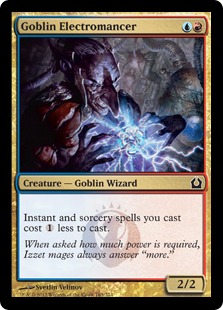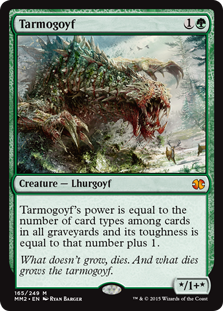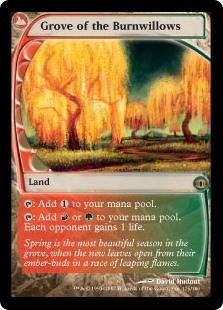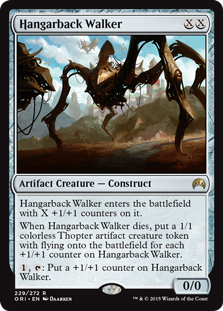Are you a Quiet Speculation member?
If not, now is a perfect time to join up! Our powerful tools, breaking-news analysis, and exclusive Discord channel will make sure you stay up to date and ahead of the curve.
Just because we're in a Modern off-season doesn't mean we can't be excited about weekend tournaments. SCG Atlanta came and went, and while Jeskai Black and Abzan Megamorph clogged up Standard's top tables, the Modern field looked far more open. Gruul Zoo! Allies! UR Storm! Restore frikkin Balance! I'm always hesitant to extrapolate too much from a 139-player event, but SCG Atlanta's Top 16 saw a number of exciting finishes and familiar faces we should pay attention to.

Trevor is off today so I'm replacing our usual Monday video with a quick breakdown of SCG Atlanta. We have a few objectives. The first is to give a framework for parsing mid-size Modern events like SCG Atlanta, balancing our excitement around cool results (holy crap Restore Balance!) with the realities of isolated tournaments. Second, we'll look at those T8/T16 results for important takeaways and technology. Today's piece will be shorter than previous tournament breakdowns, but if you have any interest in playing during the off-season, this is information you'll need to know.
[wp_ad_camp_1]
SCG Atlanta in Context
If you browse around forums and reddit as much as I do, you'll probably see (or have already seen) a lot of hyperbole surrounding SCG Premier IQs. Get ready for questions like "Is Storm tier 1 again?", "Is Abzan better than Jund?", "Is Allies finally tier 2?" and, because this is Modern, "Will Affinity (or other deck-of-the-moment) get banned soon?" To answer questions like this, and to explain those answers, we can't think about SCG Atlanta as a single defining event. Rather, we need to analyze it in the broader metagame context as both a single datapoint and as an off-season tournament.
 Before you dust off your Goblin Electromancers, let's get some perspective on SCG Atlanta. Premier IQs are not Grand Prix tournaments. They aren't even SCG Modern Opens. With a mere 139 players, SCG Atlanta is large enough to draw our attention, but too small to inform broader metagame trends. This puts observers in a weird position where we want to draw conclusions from the results but also want to respect its smaller attendance. To be sure, 139 players isn't a "small" event. Looking over attendance data collected on our Top Decks spreadsheet, we see the average Modern tournament attendance is around 49 players for a sample of 825 events. Larger events, those about one standard deviation over the average, start at roughly 195 players. If we remove GPs from the sample, our average drops to about 40 players, with the next band up falling at 70. By either of those metrics, the 139-player SCG Atlanta is solidly in the middle of mid-sized events.
Before you dust off your Goblin Electromancers, let's get some perspective on SCG Atlanta. Premier IQs are not Grand Prix tournaments. They aren't even SCG Modern Opens. With a mere 139 players, SCG Atlanta is large enough to draw our attention, but too small to inform broader metagame trends. This puts observers in a weird position where we want to draw conclusions from the results but also want to respect its smaller attendance. To be sure, 139 players isn't a "small" event. Looking over attendance data collected on our Top Decks spreadsheet, we see the average Modern tournament attendance is around 49 players for a sample of 825 events. Larger events, those about one standard deviation over the average, start at roughly 195 players. If we remove GPs from the sample, our average drops to about 40 players, with the next band up falling at 70. By either of those metrics, the 139-player SCG Atlanta is solidly in the middle of mid-sized events.
Interpreting mid-size events is much harder than identifying them. Generally speaking, we can expect a mid-size event (especially SCG Premier IQs) to be a mix of about 50% tier 1 decks and 50% "other", where the "other" category consists of tier 2 players, tier 3 challengers, and un-tiered brews with teeth. This mix follows from our metagame breakdown articles, which treat tier 1 decks as those you can expect to show up and place well in tournaments. That said, you are likely to see fewer tier 1 decks at mid-size events than large ones. You are also likely to see more lower-tier contenders. Of course, all of this is made more complicated by the lack of Day 2 data which we rely on to describe metagames at GPs and Opens.
 Off-seasons only exacerbate these difficulties. With lower stakes and fewer top-tier frontrunners, players are more likely to brew new decks or at least try new configurations of older builds. To some extent, you'll also see this at the largest events: Lantern Control is a pronounced example of this. Ad Nauseam and Grishoalbrand are more modest ones. It's more common in events like SCG Atlanta, where the payout is big enough to incentivize a serious stab at the Top 8 but the stakes are low enough that you aren't wasting a once-a-year opportunity by bringing Gruul Zoo instead of Burn. Perhaps more importantly, these smaller events are generally more open than larger ones, with fewer players, less defined metagames, and lower tier 1/tier 2 representation. All of this creates an environment that sees a mix of familiar tier 1 decks and innovative tier 2 or lower finishers.
Off-seasons only exacerbate these difficulties. With lower stakes and fewer top-tier frontrunners, players are more likely to brew new decks or at least try new configurations of older builds. To some extent, you'll also see this at the largest events: Lantern Control is a pronounced example of this. Ad Nauseam and Grishoalbrand are more modest ones. It's more common in events like SCG Atlanta, where the payout is big enough to incentivize a serious stab at the Top 8 but the stakes are low enough that you aren't wasting a once-a-year opportunity by bringing Gruul Zoo instead of Burn. Perhaps more importantly, these smaller events are generally more open than larger ones, with fewer players, less defined metagames, and lower tier 1/tier 2 representation. All of this creates an environment that sees a mix of familiar tier 1 decks and innovative tier 2 or lower finishers.
Based on this, we should consider events like SCG Atlanta from two perspectives. First, we should use them to confirm and challenge our understanding of the tier 1 metagame. Modern-wide tier 1 decks are likely to show up at these events. If they do, this reaffirms our tier 1 expectations. If not, a tier 1 shift could (but not necessarily) be underway. Second, these tournaments give an indication of what innovative decks could (but, again, not necessarily) succeed in a larger field. Even there, it's not so much specific decks as it is types of decks. Is Gruul Zoo viable? Or is rogue aggro viable? As long as you keep these measured expectations in mind, mid-size events in SCG Atlanta's category can be valuable sources of information.
Takeaways from SCG Atlanta
Here's a series of conclusions and observations we can make from SCG Atlanta. All of these follow the mid-sized event framework above, so keep that in mind when conducting your own analysis of the data.
- As mentioned earlier, we don't have Day 2 data from a Premier IQ. In fact, Premier IQs don't even have Day 2s at all. This makes it harder to get a metagame-wide picture and forces us to extrapolate purely from T8/T16 data. That means we need to be cautious in expanding our findings beyond the T8/T16 (and beyond the event).
 With the exception of Infect, all our tier 1 decks from the September metagame breakdown are alive and well. We see one RG Tron, one copy of Jund and Abzan each, two Burn decks, two Merfolks, and three Affinity (4th, 9th, and 12th). 10 of the Top 16 decks are tier 1, which suggests both that SCG Atlanta reflected the metagame and that the September trends are still ongoing.
With the exception of Infect, all our tier 1 decks from the September metagame breakdown are alive and well. We see one RG Tron, one copy of Jund and Abzan each, two Burn decks, two Merfolks, and three Affinity (4th, 9th, and 12th). 10 of the Top 16 decks are tier 1, which suggests both that SCG Atlanta reflected the metagame and that the September trends are still ongoing.
- We only see one Twin deck in the Top 16, a traditional UR Twin list in 14th place. There's also no Grixis Control in sight. Following from our September metagame breakdown, this continues the two-month trend of these URx decks performing poorly at events. I still find this odd, especially Twin's relative absence, given that Affinity was the most-played tier 1 deck in the Top 16.
 Both Naya Allies and Gruul Zoo had strong performances at the event, with Allies continuing its march to tier 2 (it's not there yet) and Gruul Zoo exploding out of nowhere to win. I'm not sure if this means the decks are good, but it does suggest that rogue aggro decks are decent choices in Modern. This confirms our longstanding suspicions about Modern being a format for linear strategies.
Both Naya Allies and Gruul Zoo had strong performances at the event, with Allies continuing its march to tier 2 (it's not there yet) and Gruul Zoo exploding out of nowhere to win. I'm not sure if this means the decks are good, but it does suggest that rogue aggro decks are decent choices in Modern. This confirms our longstanding suspicions about Modern being a format for linear strategies.
- Aside from Allies and Gruul Zoo, the other two rogue contenders were Restore Balance combo and UR Storm. As with Allies and Gruul Zoo, I don't think this necessarily means these are good decks. But also as with Allies and Gruul Zoo, I do think this means that Modern is friendly to linear decks, especially rogue decks that people aren't sideboarded for and aren't experienced playing against. Storm's finish also suggests there might not have been much Burn at this event: that is a matchup which should have prevented Storm from making Top 8.
 Robert Livingston rocked a Karplusan Forest playset instead of the traditional Grove of the Burnwillows copies. Don't be afraid to go for budget alternatives at tournaments, especially mid-size ones! Robert certainly wasn't and he has the 3rd place finish to legitimize his decision. Of course, this could also speak to the lower competition at the event.
Robert Livingston rocked a Karplusan Forest playset instead of the traditional Grove of the Burnwillows copies. Don't be afraid to go for budget alternatives at tournaments, especially mid-size ones! Robert certainly wasn't and he has the 3rd place finish to legitimize his decision. Of course, this could also speak to the lower competition at the event.
- The 11th place "Abzan" finish by Donnie Ashton is actually an Abzan Liege/Little Kid finish. Make sure to look over decklists before trusting their classification. Many sites routinely mislabel decks, which can lead to inappropriate and inaccurate conclusions. We've even done it too, although we work hard towards accuracy.
 Two of the three Affinity lists packed Hangarback Walker into their 75. Incidentally, these were the two highest-performing lists: Patrick Paris's 4th place build and Adam Mattson's 9th place finish. Affinity mages should keep exploring this creature, and Affinity opponents will need to figure out better ways to beat the resilient Walker.
Two of the three Affinity lists packed Hangarback Walker into their 75. Incidentally, these were the two highest-performing lists: Patrick Paris's 4th place build and Adam Mattson's 9th place finish. Affinity mages should keep exploring this creature, and Affinity opponents will need to figure out better ways to beat the resilient Walker.
There are a lot of other conclusions you can draw from the event but these are the big ones I caught after a few passes of the T8/T16 standings.
What else did you see at SCG Atlanta? Any stories from the event or other off-season tournaments? How do you generally interpret mid-size event data? Let me know in the comments and I'll see you all on Wednesday for a discussion of a hot-button card on Modern's banlist!




I’ve just finished collecting my paper U/R Storm deck and played it a bit at FNM. Being my first serious modern deck, it was very nice to play as I could answer pretty much all the disruption my opponents could bring. Sure, I shouldn’t say it like I played thousands games already, but still, storm can jump off against almost any match-up, except burn, of course. I like to see it getting so far even if the event itself doesn’t necessarily show full picture.
Not a lot of twin decks in top surprises me as well. At the beginning of this year (when I just started playing magic) I’ve seen it everywhere and now it all is very strange.
Storm can certainly take metagames by, well, “storm”, but I wouldn’t count on it if there’s a lot of BGx or Burn. Most tournaments will have respectable representation by both decks, so you can be making a big gamble on taking Storm to larger events. Maindeck Bolts can definitely help here, at least with Burn, with some splash relevance against Infect and Affinity.
The Twin decline is very interesting. I’m going to keep tracking it to see if it is sustained for another month or if it’s just a temporary anomaly.
Could the ur twins descendancy be associated with Merfolk’s ascendency? I figured a blue deck, especially with maindeck disruption to the combo (harbinger) could be rather difficult for twin to handle. That’s just been my experience.
That might account for part of it, but the parallel rise in Affinity and RG Tron should at least offset the smaller rise in Merfolk. I honestly think it has to do with “Twin Fatigue”, where players don’t want to play the same old deck after years. It might also relate to the rise of UW Control and other control options: Twin players might secretly be control players, and now they are moving to another control option.
I think it’s kinda sad you limit your articles to NA-only events. There was a large Modern Event last week in Italy where some unusual builds made Top8, for example an Abzan-Midrange list that featured 3 Glittering Wish in the mainboard. Or at the side-event of said tournament (which featured over 250 players aswell), where a Modern Jund list made Top8 with a full playset of Abbot of Keral Keep.
The Ovino X results are cool, but I actually think the SCG Atlanta ones are more interesting. We have both a Top 16 instead of just a Top 8, and we have a neat mix of tier 1 decks and some untiered upstarts (Allies! Storm! Restore Balance!). We can’t do an article to cover every Magic event, so it’s a matter of choose which ones are most worth analyzing. Ovino will certainly be a datapoint in the next metagame update, however!
The winner of the SCG Atlanta IQ is a local who is honestly just a very good player with a super linear deck. He has 2 GP top 8s and won our SCG States for modern with BW Tokens.